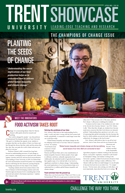Homeowners and cottagers had a rare opportunity to talk to a Trent researcher about the effects of algae on June 19, 2012 at an event in the City of Kawartha Lakes. M.Sc. candidate, Ms. Colleen Middleton, addressed a capacity crowd at the Bobcaygeon Service Centre and then took time to personally answer questions and examine samples brought in by residents.
“It was a great experience,” reported Ms. Middleton, who is working with Trent University’s renowned David Schindler professor in Aquatic Sciences, Dr. Paul Frost. “People are definitely concerned about algae levels in their lakes,” she continued, “particularly why they seem to increase. And they are doubly concerned when they realize that some of those algae blooms can, in fact, be toxic. Being able to address some of those concerns on a one-on-one basis is a pretty unique experience, both for me and, I think, for residents.”
The event, hosted by Kawartha Protect Our Water, presented Ms. Middleton with an opportunity to put her academic research to practical use and to take it out into the community directly affected by its implications. Ms. Middleton helped people to become more familiar with some of the algae common to the area and educated them on the relationships between algae growth, water quality, and the effects of human activity on watersheds.
“One of the things that I have learned at Trent is that we need to share knowledge in order for it to have any value. If you don’t share knowledge, then it is useless,” she said.
“It is important to emphasize an understanding of ecosystems,” explained Ms. Middleton. “For instance, algae are a very much needed part of aquatic ecosystems. They represent the bottom of the food web and are integral for the existence of so many other species. Most algae are harmless – though they may affect the aesthetics, enjoyment, and recreational opportunities offered by a lake. With that in mind, there are definitely questions to be asked: What is normal? What is natural? What is dangerous?”
One of the greatest concerns for cottagers who attended the event was blue-green algae – an increasing problem on many lakes in Central Ontario.
Ms. Middleton compared blue-green algae to poison ivy. “People need to identify and avoid it,” she said. They also need to take positive steps in helping reduce it and other species of algae.
“Usually, the health of a body of water will dictate the amount of algae present,” she noted. “While we need to encourage the presence of algae in a lake, we also have to realize the impact that living on and around these lakes can have on creating an overabundance. We need to address issues such as the release of phosphorus, which is present in so many household materials, including dish detergent, laundry soap, cleaning products, fertilizers, and personal hygiene products.”
According to Middleton, the audience was receptive to her message. “I think a lot of people walked away recognizing both the need for algae in a lake and the need to monitor and promote the health of their lakes in order to prevent unnecessary blooms.”
Posted on Friday, July 27, 2012.


































